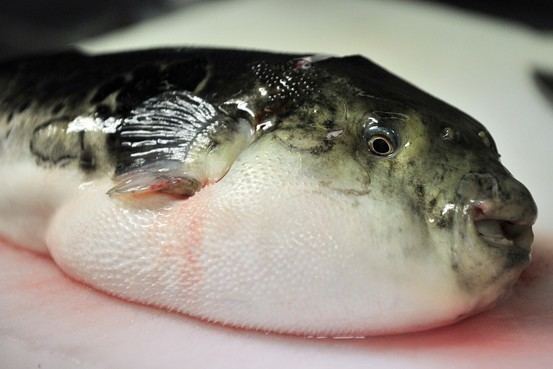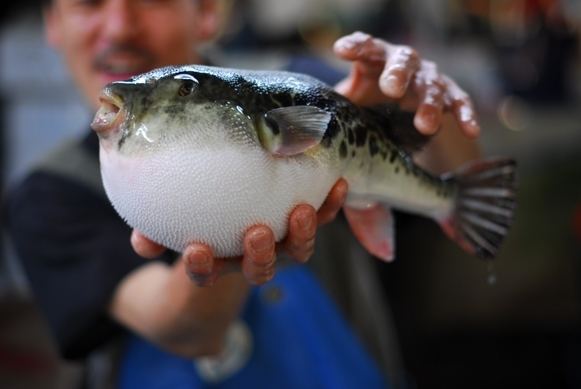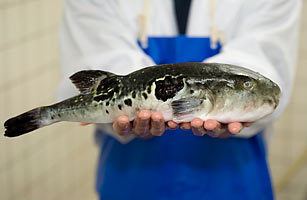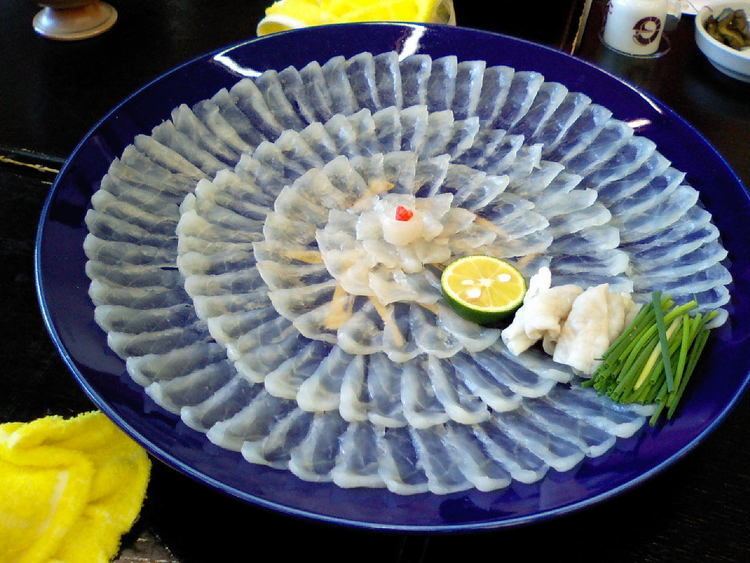 | ||
Similar | ||
Fugu fish risky japanese delicacy english version
Fugu (河豚 or 鰒; フグ) is the Japanese word for pufferfish and the dish prepared from it, normally species of genus Takifugu, Lagocephalus, or Sphoeroides, or porcupinefish of the genus Diodon. Fugu can be lethally poisonous due to its tetrodotoxin; therefore, it must be carefully prepared to remove toxic parts and to avoid contaminating the meat.
Contents
- Fugu fish risky japanese delicacy english version
- Fugu how to prepare the deadly pufferfish shown by uosei chef rikizo okamoto tokyo
- Toxicity
- History
- Species
- Regulations
- Cost
- Poison
- Treatment
- Incidents
- Preparations
- Availability
- Social aspects
- Aquaculture
- References

The restaurant preparation of fugu is strictly controlled by law in Japan and several other countries, and only chefs who have qualified after three or more years of rigorous training are allowed to prepare the fish. Domestic preparation occasionally leads to accidental death.

Fugu is served as sashimi and chirinabe. Some consider the liver to be the tastiest part, but it is also the most poisonous, and serving this organ in restaurants was banned in Japan in 1984. Fugu has become one of the most celebrated and notorious dishes in Japanese cuisine.

Fugu how to prepare the deadly pufferfish shown by uosei chef rikizo okamoto tokyo
Toxicity

Fugu contains lethal amounts of the poison tetrodotoxin in its inner organs, especially the liver, the ovaries, eyes, and skin. The poison, a sodium channel blocker, paralyzes the muscles while the victim stays fully conscious (thus making the effects somewhat similar to those of the nerve agents Sarin and VX); the poisoned victim is unable to breathe, and eventually dies from asphyxiation. Fugu poison is 1200 times stronger than cyanide, and there is no known antidote. The standard treatment is to support the respiratory and circulatory systems until the poison is metabolized and excreted by the victim's body.

Researchers have surmised that fugu's tetrodotoxin comes from eating other animals infested with tetrodotoxin-laden bacteria, to which the fish develops insensitivity over time. As such, efforts have been made in research and aquaculture to allow farmers to produce safe fugu. Farmers now produce 'poison-free' fugu by keeping the fish away from the bacteria; Usuki, a town in Ōita Prefecture, has become known for selling non-poisonous fugu.
History

The inhabitants of Japan have eaten fugu for centuries. Fugu bones have been found in several shell middens, called kaizuka, from the Jōmon period that date back more than 2,300 years. The Tokugawa shogunate (1603–1868) prohibited the consumption of fugu in Edo and its area of influence. It became common again as the power of the shogunate weakened. In western regions of Japan, where the government's influence was weaker and fugu was easier to get, various cooking methods were developed to safely eat them. During the Meiji Era (1867–1912), fugu was again banned in many areas. Fugu is the only food the Emperor of Japan is forbidden to eat, for his safety.
Species
The torafugu, or tiger blowfish (Takifugu rubripes), is the most prestigious edible species and the most poisonous. Other species are also eaten; for example, Higanfugu (T. pardalis), Shōsaifugu (T. vermicularis syn. snyderi), and Mafugu (T. porphyreus). The Ministry of Health, Labour and Welfare of Japan provides a list that shows which species' body parts can be consumed. The list names safe genera including pufferfish of the Lagocephalus and Sphoeroides genera and the related porcupinefish (Harisenbon) of the family Diodontidae.
Regulations
Strict fishing regulations are now in place to protect fugu populations from depletion. Most fugu are now harvested in the spring during the spawning season and then farmed in floating cages in the Pacific Ocean. The largest wholesale fugu market in Japan is in Shimonoseki.
Fugu prices rise in autumn and peak in winter, the best season, because they fatten to survive the cold. Live fish arrive at a restaurant, surviving in a large tank, usually prominently displayed. Prepared fugu is also often available in grocery stores, which must display official license documents. Whole fish may not be sold to the general public.
Since 1958, fugu chefs must earn a license to prepare and sell fugu to the public. This involves a two- or three-year apprenticeship. The licensing examination process consists of a written test, a fish-identification test, and a practical test, preparing and eating the fish. Only about 35 percent of the applicants pass. Small miscalculations result in failure or, in rare cases, death. Consumers believe that this training process makes it safer to eat fugu in restaurants or markets. Also, commercially available fugu is sometimes grown in environments in which it grows to be less toxic.
Since October 2012, restaurants in Japan have been permitted to sell fugu which has been prepared and packaged by a licensed practitioner elsewhere.
Cost
A dish of fugu typically costs between ¥2,000 (approx. US$20) and ¥5,000 (approx. US$50); a full-course fugu meal (usually eight servings) can cost ¥10,000–20,000 (approx. US$100–200). The expense encourages chefs to slice the fish very carefully to obtain the largest possible amount of meat. The special knife, called fugu hiki, is usually stored separately from other knives.
Poison
Tetrodotoxin (TTX) is a natural product that has, as of 2015, been isolated from puffer fish, but also from octopuses, from crabs and shellfish, from frogs and newts, as well as other aquatic animals (see below). It is a potent neurotoxin that shuts down electrical signaling in nerves; it acts via interaction with components of the sodium channels in the cell membranes of those cells. It does not cross the blood–brain barrier. In the case of the pufferfish host, at least (see below), their insusceptibility to the poison results from a mutation in their sequence of their specific types of sodium channel proteins.
TTX is not produced by puffer fish and the other aquatic animals from which it has been isolated; rather, bacteria such as Alteromonas, Shewanella, and Vibrio species infect or cohabit with the animal species from which TTX is isolated, and a bacterial biosynthetic pathway for its production has been rationalized.
In animal studies with mice, the median lethal dose of TTX was found to be 8 μg per kg body weight. Tetrodotoxin levels are affected by preparation (removal of most toxic materials, treatments such as curing and pickling, see below); it is, however, reportedly not significantly affected by cooking.
Treatment
The symptoms from ingesting a lethal dose of tetrodotoxin may include dizziness, exhaustion, headache, nausea, or difficulty breathing. The victim remains conscious but cannot speak or move. Breathing stops and asphyxiation follows.
There is no known antidote, and treatment consists of emptying the stomach, feeding the victim activated charcoal to bind the toxin, and putting the victim on life support until the poison has worn off. Toxicologists have been working on developing an antidote for tetrodotoxin.
Incidents
Statistics from the Tokyo Bureau of Social Welfare and Public Health indicate 20 to 44 incidents, some affecting multiple diners, of fugu poisoning per year between 1996 and 2006 in Japan. Between 34 and 64 victims were hospitalized, and zero to six died, per year, with an average fatality rate of 6.8%. Of the 23 incidents reported in Tokyo from 1993 through 2006, only one took place in a restaurant; all others involved people catching and eating the fish. Poisonings through amateur preparation can result from confusion between types of puffer, as well as improper methods, and some may represent deliberate suicide attempts. Engelbert Kaempfer, a German physician who resided in Japan in the 1690s, reported that an unusually toxic variety of puffer was sometimes sought out by individuals who wished to take their own lives.
Much higher figures were reported in earlier years, peaking in 1958 when 176 people died. According to the Fugu Research Institute 50% of the victims were poisoned by eating the liver, 43% from eating the ovaries, and 7% from eating the skin. One of the most famous victims was the Kabuki actor and "Living National Treasure" Bandō Mitsugorō VIII, who in 1975 died after eating four servings of fugu kimo (fugu liver), the sale of which was prohibited by local ordinances at the time. Bandō claimed to be able to resist the poison, but died several hours after returning to his hotel.
On August 23, 2007, a doctor in Thailand reported that unscrupulous fish sellers sold puffer meat disguised as salmon, which caused fifteen deaths over three years. About 115 people were taken to different hospitals. Fugu had been banned in Thailand five years prior to the deaths.
In March 2008 a fisherman in the Philippines died and members of his family became ill from pufferfish. The previous year, four people in the same town died and five others had fallen ill after eating the same variety of pufferfish.
In February 2009 a Malaysian fisherman died and four others were hospitalised after they consumed a meal of puffer fish when they ran out of food while at sea.
In November 2011 a chef at two-Michelin star "Fugu Fukuji" in Tokyo was suspended from his post. The chef served fugu liver to a customer who, despite being warned of the risks, specifically asked that it be provided. The 35-year-old customer subsequently required hospital treatment for mild symptoms of tetrodotoxin paralysis, but made a full recovery.
Five men were poisoned at a restaurant in Wakayama in March 2015 after specifically asking for liver.
Preparations
The role of the Fugu chef is not to eliminate the toxin altogether, but to reduce it, to the extent that the diner experiences effects of mild intoxication, including waves of euphoria and tingling sensations.
In the cuisine of Hakusan, Ishikawa, ovaries are served after effort is made to reduce the toxin level by salting and pickling—e,g, in "Blowfish Ovaries Pickled in Rice-Bran Paste" (河豚の卵巣の糠漬け, ふぐのらんそうのぬかづけ). Only the "Mikawa district of Hakusan City, the Ono and Kanaiwa districts of Kanazawa City, and Wajima City, all in Ishikawa Prefecture" are permitted to perform the process, and only by the traditional method, and explicit warnings are offered to dissuade non-professionals from attempting the 3-year process. After one year of pickling—about a third of the way through the process—about 10% of the toxin is suggested to remain, and after the full three years the product is "only sold after having been checked for safety through a toxicity inspection, and other tests."
Availability
Most Japanese cities have one or more fugu restaurants. They may cluster, because of earlier restrictions, as proximity made it easier to ensure freshness. A famous restaurant specializing in fugu is Takefuku, in the Ginza district in Tokyo. Zuboraya is another popular chain in Osaka.
In South Korea, fugu is known as bok-eo (복어). It is very popular in port cities such as Busan and Incheon. It is prepared in a number of dishes such as soups and salads, and commands a high price.
In 2003 only seventeen restaurants in the United States were licensed to serve fugu; twelve of those were in New York City. Since that year, some other American restaurants have offered fugu.
The fugu is cleaned of the most toxic parts in Japan and freeze-flown to the USA under license in customized, clear, plastic containers. Fugu chefs for U.S. restaurants are trained under the same rigorous specifications as in Japan. Pufferfish native to US waters, particularly the genus Spheroides, have also been consumed for food, sometimes resulting in poisonings.
Sale of fish belonging to this genus is forbidden altogether in the European Union.
Social aspects
In the Kansai region, the slang word teppō, (鉄砲) meaning rifle or gun, is used for the fish. This is a play of words on the verb ataru (当たる), which can mean to be poisoned or shot. In Shimonoseki region, the ancient pronunciation fuku is more common instead of the modern fugu. The former is also a homonym for good fortune whereas the latter is one for disabled. The Tsukiji fish market fugu association holds a service each year at the height of the fugu season, releasing hundreds of caught fugu into the Sumida River. A similar ceremony is also held at another large market in Shimonoseki.
A rakugo, or humorous short story, tells of three men who prepared a fugu stew but were unsure whether it was safe to eat. To test the stew, they gave some to a beggar. When it did not seem to do him any harm, they ate the stew. Later, they met the beggar again and were delighted to see that he was still in good health. After that encounter, the beggar, who had hidden the stew instead of eating it, knew that it was safe and he could eat it. The three men had been fooled by the wise beggar.
Lanterns can be made from the bodies of preserved fugu. These are occasionally seen outside of fugu restaurants, as children's toys, as folk art, or as souvenirs. Fugu skin is also made into everyday objects like wallets or waterproof boxes.
Aquaculture
Scientists at Nagasaki University have reportedly succeeded in creating a non-toxic variety of torafugu by restricting the fish's diet. After raising over 4,800 non-toxic fish, they are fairly certain that the fish's diet and digestive process actually produce the toxins. The non-toxic version is said to taste the same. Some skeptics say that the fish being offered as non-toxic may be of a different species, and that the toxicity has nothing to do with the diet of the pufferfish.
